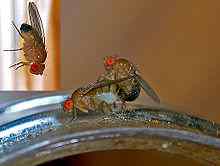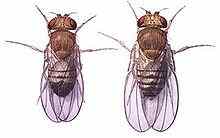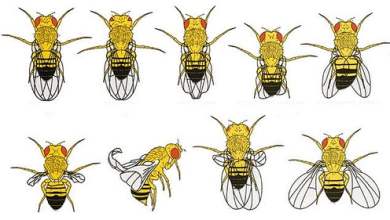Drosophila Melanogaster are now referred to as the common term “fruit flies” or “vinegar fly”. Although they may seem to just be a nuisance, they are the most widely studied and researched bug in the world. Major fields of study include microbial pathogenesis and genetics. One of the primary reasons why fruit flies are so widely studied is due to their extremely fast breeding rate. Since a entire new generation of fruit flies can come into existence in less then 170 hours, it is no wonder that they are examined closely. Before you continue, I just want to warn you that this is a rather scientific explanation on fruit flies and may be a little hard to understand. I will however, try and keep it as simple as possible and when it really comes down to it, its really not that hard if you put your mind to it. This information is extremely useful for school or even university projects and many people have used it for that exact purpose. If you are simply looking to remove fruit flies, check out this fruit fly trap remedy that works well.
What Is a Drosophila Melanogaster?
Frequently referred to as a fruit fly, it is usually found flying around your fruit bowel, especially if the fruit has been there for a long time. They are usually about 0.3cm long and although they are a huge frustration for us, as previously mentioned they are a huge part of biological research in most laboratories that focus on genetic research. In fact, recent studies show that there are over 7000 scientists that study this bug worldwide as a fulltime job. In fact, research made on the fruit fly and how it has helped improve our understanding of genetics earned a Nobel prize in medicine in the 1990’s.
Without going into any huge technical detail, the average fruit fly has just under 15 nucleon separations before the embryo is formed. It is during these separations that genetic scientists are able to make their modifications to the DNA structure. Compared to other insects, the fruit fly gene pattern is one of the most widely understood due to the extensive studies conducted on the insect. As a result, this allows precise modifications to be made with a very good survival rate. Once these basic functions are complete, the fly hatches into a larvae form. At this point, all genetic modifications must have been made.
While in this form, small discs form within the larvae. This creates the basic structure of the fruit fly and these discs mimic the genetic code that was formulated (and potentially scientifically modified) while still in the egg. Once they are in the metamorphosis stage, the fruit fly is build around these structures to give each fly a unique characteristic while still maintaining the basic shape of a regular fruit fly.
The Fruit Fly Genome
What exactly is a Genome? Well, it’s the biological map that is contained within the DNA of every living thing on this planet. They all form part of what makes up a unique gene pool. When it comes to fruit flies, each genome contains over 13 000 genes. In order to manipulate the gene structure of the fruit fly, they need to be sequenced and this process is almost complete. In fact, scientists have already been able to make hundreds of successful modifications to the genes of fruit flies.
Another very interesting fact about fruit fly DNA is that the genes have an almost identical match to many well known human diseases much as Alzheimer’s and Diabetes. This allows scientists to study the formulation of these diseases in an attempt to find possible cures. Fruit fly genetics research has been extensive and has contributed to much about what is known about genetic modification. Charles W. Woodworth pioneered this movement and was the first one to start breeding fruit flies in huge numbers in order to conduct research on them. It was in his laboratories that the first fruit fly gene mappings took place and these chromosomes (groups of genes) have been used ever since (and improved upon of course – also known as Drosophila Melanogaster Sexing)
Drosophila Melanogaster Polytene Chromosomes
In order to increase cell volume during the initial stages of development, the DNA replicates multiple times but does not increase cell division. This usually results in a rather large DNA “membrane” that can be viewed using a microscope. In addition, this membrane that is formed has specific patterns that mimic that of a bar code that you would find on various clothing at shopping centers. Using this “bar-code” as a reference, genetic scientists are able to easily identify various parts of the Polytene Chromosomes and map out the gene makeup of the fruit fly. This can be used for the basis of genetic alternation.
Drosophila Melanogaster Model Organism
As previously mentioned, the fruit fly gene is studied extensively in genetics. Why is that so? Here are a few reasons why scientists use the fruit flies DNA as a model for genetic research.
- Fruit flies breed quickly and cost almost nothing to grow thousands at a time in a controlled environment. In addition, the female fruit flies lay up to 400 eggs every 16 days or so which helps the population grow quickly.
- Its easy to accelerate their growth (from egg to larvae for example) by introducing heat. This can reduce the egg stage of the fruit fly development to as little as 7 days.
- The fruit flies have very large chromosomes (part of the DNA membrane) that can easily be studied via a microscope and mapped into specific gene characteristics. This allows for easy manipulation of the Drosophila Melanogaster genes and this is the reason for the thousands of fruit fly species we have in the world today, despite there only being a couple hundred initially in nature.
- The gene was mapped in the year 2000 which allows scientists to genetically modify the fruit fly with a very high success rate. This ability has fast tracked many genetic research projects as scientists have a base from which to work.
Drosophila Melanogaster Anatomy
Regular fruit flies have red eyes and their bodies are generally a mixture between brown and yellow. Their general length is about 0.3cm. Usually the male fruit flies have a slightly darker body then the females. Another characteristic of the male fruit fly is a larger black spot on the abdomen, as shown in this picture. (the male is on the far left). As you can see, the male fruit flies are also slightly smaller then the females which is rather unusual in nature. While mating, the male fruit fly attaches himself to the female with very small hair like bristles before inseminating his target.
Since fruit flies have had their genes mapped out, there are thousands of species in the world today whereas initially, there were only a couple hundred. These genetic mutations have resulted in rather odd looking wing formations and other changes in the fruit flies color and body structure. If you would like a simpler explanation on where do fruit flies come from in the house, you can follow that link for an easier guide.
Drosophila Melanogaster Mutation and Phenotype
The instructions that are used to build any living thing is precisely mapped out in its DNA, kind of like a blueprint that may be used by an architect to build a complex structure. The blueprint does not contain just one type of information but rather contains all the instructions needed for all aspects of the building. Likewise, each part or structure of the fruit fly has its own chromosomes (a group of genes) in the DNA which is used to construct its unique characteristics.
If the architect of a building introduced a weakness in the structure, the entire building will suffer as a result. Likewise, each gene in each chromosome (contained within the DNA) must work together if the fruit fly is to survive. This is why altering the genetic makeup of a living thing is dangerous and often results in its death. With fruit flies however, the gene sequence has been mapped in its completion and as a result, scientists can make adjustments with a very high survival rate. I am not suggesting that the genetic mutation is always beneficial to the bug but at least it doesn’t die from the adjustments. Sometimes, genetic manipulation can even be beneficial for the species, as it can fix deformities such as flightless fruit flies and other things like that. However, the process of genetic alteration doesn’t often go down well with the general community as many feel that they are “playing God”. I always argue the fact that they are not creating new life forms but rather are just making modifications to existing ones. But that is just my personal opinion on the matter and you are feel to have your own point of view.
What Do These Fruit Flies Eat?
Fruit flies typically feast on rotten fruit (hence their name) but are also often found on old vegetables and other food. They have a highly trained sense of smell and are attracted to sugary substances. Female fruit flies usually eat more often then their male counterparts since they are expected to lay over 300 eggs when they reproduce. However, both the male and female fruit flies typically have a rather small calorie intake (in relation to their size) due to the high levels of sugar present in their food.
Fruit Fly Characteristics and Traits
Typically, fruit flies are very active for an hour or so before resting. This process repeats itself over a 24 hour period with no long periods of sleep. This is known as the fruit flies activity rhythm. Each fruit fly has what is known as a “biological clock”, something that is present in humans. This allows them to perform activities at the exact same time each day, something that is critical for feeding and breeding.
Further studies on their characteristics show that fruit flies even have traits like courtship (between the male and female fruit fly), pain and even possess the ability to learn. Genetic scientists are able to learn this but isolating the gene responsible for these characteristics.
Another interesting trait is that during courtship, the male fruit flies actually sing to the females by rubbing their wings together. This creates a low frequency sound that attracts the females of a similar genetic makeup. This ensures that only compatible pairs mate. Getting rid of fruit flies can be challenging, check that post to find out more information.
Drosophila Melanogaster Eye Color
The two main types of eye color are created using two different pathways, the Drosopterin pathways is responsible for creating the red color, whereas the ommochrome pathway is responsible for the creation of the brownish colors. Scientists have been able to manipulate this gene pathway and create different colors. Examples of this were shown in the pictures above (black, orange, etc.).
Fruit flies have played a major part in the advancement of genetic research. In fact, without the help of these fruit flies, the speed in which we have come to understand other parts of genetics (including humans) would have been severely reduced. So although they might be very frustrating for you, just remember that they serve a very important role in science. I hope that this has been informative and I would like to thank you for taking the time to read my article on the amazing facts about the Drosophila Melanogaster. 🙂
Hello! My name is Natasha, and I have been helping people with their insect problems since 2012. I have published a book, worked with many pest control companies, and helped thousands with various infestations on a one-to-one basis. My goal for this blog is to create evidence-based guides that are easy to understand, provide sufficient depth and can be trusted to be very accurate. Please remember that my guides are for informational purposes only, and that you agree to the terms of use when reading content on this website. If you leave a comment, I typically respond within 48 hours.







Hi Natasha,
Do you know the licensing of the Drosophila mutant image (bottom image)? I’m wondering if I could use it in an academic paper. Thanks!
-Paul
Hi Paul! If you mouse over the little grey box (on the image), it will show you the license information 🙂
Very interesting. I have wondered about the fruit fly for years. It says a female can lay up to 400 eggs every 16 days. I was wondering –
How long is the process from a female laying one egg to when that fruit fly can literally fly? (About)
Also how many of those 400 eggs survive?(percentage) -Thanks for all of the information.
Hey Matt! It takes about 5-7 days (depending on the temperature) for them to go from eggs to flying around. As for the survivors, it really depends on the environmental conditions. If there is no outside influence, a large majority will hatch and progress to adulthood. Hope that helps and glad you liked my article. 🙂
I can’t find an answer to the following questions anywhere:
I am ripening some pears on my kitchen counter. 2 days ago I noticed fruit flies starting to appear, and today there is a rather large number, probably 10-15 flies. They are just now ripe enough to begin the canning process, but are they ruined now? Should they be thrown out or would cooking the pears save them? Thank you ahead of time.
Hey Kyle. The fruit flies will not make the fruit poisonous or anything. If there is no visible damage, you can use them. Good luck!
I think this is a fruit fly but the eyes are black. The body is 2 mm. It must be a female by the markings. Also how can I get rid of them and where are they laying their eggs? Another thing, I only ever see 1 or 2 at a time.
Hey Tom! While fruit flies usually have dark red eyes, they can appear black. Please check out a few images on Google to make sure that they are not Phorid flies. If you are 100% sure that they are fruit flies, check out my guide on “how to get rid of fruit flies” (on this blog) and let me know if you have any questions once you have read over it 🙂 Good luck!
Thank you for the mutation information and general pictures; I have been trying to identify a small insect I killed the other day that I believed was too large to be a fruit fly and most resembled a hornet with some reverse patterning in the yellowish-copper and blackish-orange areas; I now believe it was not a small hornet but really just an oversize fruit fly.
Hey Shell. While that is possible, fruit flies don’t usually get that big. I don’t suppose you have a picture of it do you? I would love to see it, perhaps I could even share it with others on this blog 🙂
This was the most helpfull article in my research project for biology, thank you so much for explaining it in a way that i can actually understand!
Hey Izzy! Its a pleasure, I am glad that you found it useful! I hope that you do well in your project 🙂
Wow this is gonna help me ALOT in the next week, is all this info accurate? Don’t want to learn the wrong thing for my exam.
Thx Megz
Its all 100% accurate. Use it as a study aid and feel free to contact me (via the contact form) if you find anything else that is interesting 🙂
The Drosophila has been such a huge part of genetic research and its sad that hardly anyone knows or just thinks that fruit flies are only meant irritate them. Its a complex subject and I think you did a good job at explaining it.
Thanks for the article
Cheers!
Thank you for your kind words and for taking the time to comment. Good luck with your project and I am glad that you found the information useful.
I grew to hate D. metgnoaasler durung the last school year because we had to work with them so much in our Biology lab classes. In one experiment, we had to calculate the recombination frequency between two X-linked genes in D. metgnoaasler. Basically this entailed crossing some male and female D. metgnoaasler, waiting until the F2 generation matured, and then counting hundreds and hundreds of these flies while looking for ridiculous mutations like singed hairs instead of normal hairs or scalloped wings instead of normal wings. I refuse to work with D. metgnoaasler ever again. Screw genetics
Hey Gabrielli! Indeed, I am not a master an any genetic science but I did find that there was a huge lack of a simple explanation on this subject. Fruit flies have definitely helped us progress in this field but I suppose its not for everyone. Thanks for taking the time to comment 🙂